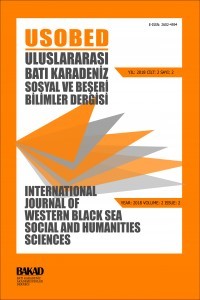KRİPTO PARA PİYASALARINA DAYALI STATİK VE DİNAMİK PORTFÖY OPTİMİZASYON ANALİZLERİ
Bu çalışmada kripto para piyasalarına dayalı statik ve dinamik portföy optimizasyon analizlerine yer verilmiştir. Analizlerde şartlı riske maruz değer yöntemi, risk paritesi yöntemi, minimum varyans yöntemi, Shrape rasyosu yöntemi ile eşit ağırılıklandırma yöntemi kullanılmıştır. Portföy performanslarının ölçümünde Sortino rasyosu, Calmar rasyosu, Sharpe rasyosu ile değişim katsayılarından yararlanılmıştır. Optimal portföylerin finansal risk düzeylerinin ölçümünde ise tarihi simülasyon yöntemi, şartlı riske maruz değer yöntemi ile maksimum düşüş oranına yer verilmiştir. Hem statik hem de dinamik portföy optimizasyon analizine dayalı bulgular her durumda en iyi performansı sergileyen yöntemin eşit ağırlıklandırma yöntemi olduğu sonucuna işaret etmektedir. Bulgular ayrıca normal piyasa koşullarında eşit ağırlıklandırma yöntemi ile oluşturulan portföyün makul bir piyasa risk düzeyine sahip olduğunu, fakat kripto para piyasalarındaki volatilitenin oldukça artığı dönemlerde eşit ağırlıklandırma yöntemi ile oluşturulan portföyün en yüksek piyasa riskine sahip portföy olma riskinin de bulunduğunu göstermektedir.
Anahtar Kelimeler:
Kripto para piyasaları, Portföy Optimizasyonu, Portföy riski, Cryptocurrency Markets, Portfolio Optimization, Portfolio Risk Management
STATIC AND DYNAMIC PORTFOLIO ALLOCATION ANALYSIS BASED ON CRYPTOCURRENCY MARKETS
In this study, static and dynamic portfolio allocation analyzes based on cryptocurrency markets areconducted. Conditional value at risk method, risk parity method, minimum variance portfolio and equal weightedportfolio are used in the analyzes. Sortino ratio, Calmar ratio, Sharpe ratio and coefficients of variation are appliedin order to evaluate the performances of the optimal portfolios. In the measurement of financial risk levels of theoptimal portfolios, the historical simulation method, the conditional value-at-risk method and the maximumdrawdown are used. The results based on both static and dynamic portfolio allocation analysis indicate that equalweighted portfolio is the best performing of the methods examined. The findings also show that though theportfolio created with the equal weighted portfolio has a reasonable market risk level under normal marketconditions, in the periods when the volatility in the cryptocurrency markets is quite high, the portfolio created withthe equal weighted portfolio also has the highest market risk.
Keywords:
Cryptocurrency Markets, Portfolio Optimization, Portfolio Risk Management, Cryptocurrency Markets, Portfolio Optimization, Portfolio Risk Management,
___
- Alankar, A., DePalma, M. ve Scholes, M. (2012). An Introduction to Tail Risk Parity, Balancing Risk to Achieve Downside Protection, 1-25. https://www.alliancebernstein. com/abcom/ segment_homepages/defined_benefit/3_emea/content/pdf/introduction-to-tail-risk-parity.pdf. (Erişim Tarihi: 28.07.2022).
- Aljinović, Z., Marasović, B., Šestanović, T. (2021). Cryptocurrency Portfolio Selection: A Multicriteria Approach. Mathematics, 9 (1677), 1-21.
- Al-Mansour, B.Y. (2020). Cryptocurrency Market: Behavioral Finance Perspective. Journal of Asian Finance, Economics and Business, 7 (12), 159-168.
- Anghel, D-G. (2021). A Reality Check On Tarding Rule Performance In The Cryptocurrency Market: Machine Learning Vs.Technical Analysis, Finance Reserach Letters, 39,1-8.
- Braga, M.D. (2015). Risk Parity Versus Other P-Free Strategies: A Comparison In A Triple View. Investment Management and Financial Innovations, 12(1), 277-289.
- Brauneis, A., Mestel, R. (2019). Cryptocurrency-Portfolios In A Mean-Variance Framework. Finance Reserch Letters, 28,259-264. Burggraf, T. (2019). Risk-Based Portfolio Optimization Cryptocurrency World, SSRN, 102, 1-52.
- Castro, J.G., Tito, E.A.H., Brandao, L.E.T., Gomes, L.L. (2020). Crypto-Assets Portfolio Optimization Under The Omega Measure. The Engineering Economist, 65 (2), 114-134.
- Gül, Y. (2020). Kripto Paralar Ve Portföy Çeşitlendirmesi. Dumlupınar Üniversitesi Sosyal Bilimler Dergisi, 65, 125-141.
- Hrytsiuk, P.,Babych, T., Bachyshyna,L. (2019). Cryptocurrency Portfolio Optimization Using Value-At-Risk Measure. Advances in Economics, Business and Management Research, 95,385-389.
- Kisiala, J. (2015). Conditional Value-at-Risk: Theory and Applications. (Dissertation Presented for the Degree of MSc in Operational Research), The University of Edinburgh, The School of Mathematics. https://arxiv.org/pdf/1511.00140.pdf. (Erişim Tarihi: 12.07.2022).
- Li, Z., Meng, Q. (2022). Time And Frequency Connectedness And Portfolio Diversification Between Cryptocurencies And Renewable Energy Stock Markets During COVID-19. North American Journal of Economics and Finance, 59,1-15.
- Lucarelli, G., Borrotti, M. (2020). A Deep Q-Learning Portfolio Management Framework For The Cryptocurrency Market. Neural Computing and Applications, 32, 17229-17244.
- Maciel, L. (2020). Cryptocurrencies Value-At-Risk And Expected Shortfall: Do Regime-Switching Volatility Models Improve Forecasting ? International Journal of Finance and Economics, 26(3), 4840-4855.
- Magnus, M., Margerit, Mesnard,B., Korpas, A. (2017). Upgrading the Basel standards: from Basel III to Basel IV? , European Parliament, Economic Governance Support Unit,1-15. https://www.europarl.europa.eu/RegData/etudes/ BRIE/2016/587361/ IPOL BRI(2016)587361_EN.pdf. (Erişim Tarihi: 28.06.2022).
- Markowitz, H. (1952). Portfolio Selection. The Journal of Finance, 7(1), 77–91
- Mba, J.C., Mwambi, S. (2020). A Markov-Switching COGARCH Approach To Cryptocurrency Portfolio Selection And Optimization. Financial Markets and Portfolio Management, 34,199-214.
- Mba, J.C., Pindza, E., Koumba, U. A. (2018). A Differential Evolution Copula-Based Approach For A Multi-Period Cryptocurrency Portfolio Optimization. Financial Markets and Portfolio Management, 32, 399–418
- Nawapong, W., Chanson,P. Chaiyawat,T., Sattakulpiboon, I. (2019). Value-at-Risk of Stock and Cryptocurrency Portfolio Diversification. 1st International Conference in Business and Economics, Bangkok, Thailand,13-15 March.
- Phillips, P. C. B., Perron, P. (1988). Testing For A Unit Root İn Time Series Regression. Biometrika, 75, 335–346.
- Platanakis, E., Sutcliffe, C., Urquhart, A. (2018). Optimal Vs. Naïve Diversification In Crytocurrencies. Economic Letters, 171, 93-96.
- Rockafellar, R. T., Uryasev,S. (2000). Optimization of Conditional Value at-Risk. Journal of Risk, 2(3), 21– 41.
- Schellinger, B.(2020).Optimization Of Special Cryptocurrency Portfolios. The Journal of Risk Finance, 21(2), 127-157.
- Silahli, B., Dingec, K.D., Cifter, A., Aydin, N. (2021). Portfolio Value-At-Risk With Two-Sided Weibull Distribution: Evidence From Cryptocurrency Markets. Finance Research Letters , 38, 1-8.
- Stavroyiannis, S. (2018). Value-At-Risk And Related Measures For The Bitcoin. The Journal of Risk Finance,19 (2) , 127-136.
- Başlangıç: 2017
- Yayıncı: Batı Karadeniz Akademisyenler Derneği (BAKAD)
Sayıdaki Diğer Makaleler
KRİPTO PARA PİYASALARINA DAYALI STATİK VE DİNAMİK PORTFÖY OPTİMİZASYON ANALİZLERİ
Önder BÜBERKÖKÜ, Celal KIZILDERE
Veysel Mehmet GÜLTEKİN, H. Mustafa PAKSOY
TURİZM VE SAĞLIK TURİZMİNDE TALEP TAHMİNİ ÇALIŞMALARI: BİR ALAN YAZIN TARAMASI
Mustafa Necati ÇOBAN, Fatih YETER, Nalan KANGAL
TÜRKİYE CUMHURİYETİNDE İŞ SAĞLIĞI VE GÜVENLİĞİ SİSTEMİNİN TEMEL DİNAMİKLERİ VE UYGULAMA ALANI
AZINLIK GİRİŞİMCİLİĞİ VE SOSYAL AĞ DEĞİŞKENLERİNİ ELE ALAN LİTERATÜR İNCELEMESİ VE TARTIŞMA
Meri TAKSİ DEVECİYAN, Fatma Şebnem ARIKBOĞA
KÜLTÜREL ZEKANIN DEMOGRAFİK DEĞİŞKENLERE GÖRE İNCELENMESİ
